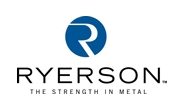Steel Mills

Ryerson Looking to Strong Second Quarter
Written by Sandy Williams
May 2, 2018
Ryerson Holding Corp. reported an exceptional first quarter with net income of $10.4 million and revenue of $942.3 million. First-quarter revenue improved 16.1 percent over fourth quarter due to higher volume, seasonal improvement, and higher average selling price.
Ryerson shipments totaled 526,000 tons for the quarter at an average selling price of $1,790 per ton. Shipments were up 11.9 percent from Q4 and 5.8 percent from Q1 2017.
Carbon steel shipments totaled 394,000 tons, up 11.0 percent from Q4 and 5.3 percent higher than a year ago.
CEO Eddie Lehner expects second quarter demand and pricing will continue to improve. Volume growth was up across all of end markets, most notably in metal fabrication and machine shops, commercial ground transportation, HVAC, and oil and gas.
Although trade actions reduced metal imports by 9 percent in first quarter compared to Q1 2017, “imports have proven more resilient than predicted,” said Lehner, as evidenced by April import licensing data.
Regarding Section 232, Lehner noted that themes are emerging in negotiations and there is much left to play out regarding the tariffs. “The way we’ve seen the 232 is it has certainly disrupted supply chains. I think for suppliers and/or distributors that had majority imported supply chains, they’ve probably gone through some disruption, as well as folks that maybe didn’t want to put forth as much working capital investment and didn’t have the right configuration of domestic supply relationship.”
Gross margins are looking good, said Lehner, and the company is managing cost pressures well. “I think the bigger challenge–and it is a challenge I’m very confident we’ll meet–is how you peel those layers of cost off when we inflect,” said Lehner. “And when that inflection looks like it’s going to have some duration to it.”
Lehner noted the importance of understanding inventory. “There is traditionally what I call a sediment layer of inventory that we called dormant inventory, right? So it’s inventory that sticks around and hangs around for a long time.”
“As we better use analytics to understand our inventory, and that sedimentary layer of inventory works its way down, we’re able to make incremental investments in faster turning items. Again, based on analytical visibility that we have now that we didn’t have four to five years ago, we’re able to invest very well where we see better demand and not take positions in inventory that hangs around the business longer than we would like.”
Kevin Richardson, President, Southeast Region, anecdotally mentioned during the earnings call that some of Ryerson’s large OEM customers are having difficulty finding enough skilled labor to meet backlogs.

Sandy Williams
Read more from Sandy WilliamsLatest in Steel Mills

Cliffs unveils new hydrogen-powered stainless line in Ohio
CEO Lourenco Goncalves, flanked by state leaders and union reps, touted the project as proof that US manufacturing is not only alive, but also advancing.

Cliffs idles Steelton, Riverdale, and Conshohocken operations
Cliffs has idled facilities in Riverdale, Ill., and Conshohocken and Steelton, Pa.

Radius loss narrows, volumes climb in ‘healthy’ West Coast market
Stronger steel demand in the Western US, rising scrap flows, and improved rolling mill utilization drove sequential gains for Portland, Ore.-based Radius Recycling.

AISI: Raw steel production backs off multi-year high
US raw steel output edged lower last week after hitting a multi-year high in mid-June, according to the American Iron and Steel Institute (AISI).

Private equity firm Atlas Holdings to acquire Evraz North America
Atlas Holdings said it has signed a definitive agreement to acquire Evraz North America (Evraz NA). The Greenwich, Conn.-based private equity firm said it expects the deal for the Chicago-based steelmaker to close in the second quarter of 2025 subject to various closing condition.
